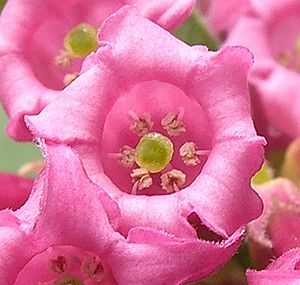Purple cestrum facts for kids
Quick facts for kids Purple cestrum |
|
|---|---|
 |
|
| Scientific classification | |
| Genus: |
Cestrum
|
| Species: |
elegans
|
Cestrum elegans, also known as purple cestrum or red cestrum, is a type of flowering plant. It belongs to a group of plants called Cestrum. People sometimes call it "bastard jasmine."
Contents
History of the Purple Cestrum
Cestrum elegans is part of the plant family called Solanaceae. This family name comes from an old Greek word for a plant that was hard to define. Other names for this plant used to be C. purpureum and C. paniculatum.
The plant was first found by Henri Guillaume Galeotti in Mexico in 1837. At first, it was named Habrothamnus elegans. Later, in 1846, a German botanist named Diederich Franz Leonhard von Schlechtendal officially changed its name to Cestrum elegans. This new name fit the way plants were being named at the time. People started growing Cestrum elegans in Europe as a pretty garden plant around 1840.
What Does Cestrum elegans Look Like?
Cestrum elegans is a tall, thin evergreen plant. It can grow up to seven feet (about 2 meters) high. It doesn't have many branches, making it look very neat.
Its leaves are green and shaped like an oval with pointed tips. They grow in an alternating pattern along the stem and can be up to eight centimeters long. The leaves have a strange smell, but the flowers smell sweet!
Flowers and Berries
The plant produces bright purplish-red flowers that look like funnels. Each flower is about 2 centimeters long and has five pointed parts. These flowers bloom from August to March.
When the plant grows in warm places, its leaves feel soft and fuzzy. Young stems are covered in purplish hairs, which turn woody as the plant gets older. After the flowers, the plant can grow berries. These berries are a dark red color.
Growing Conditions
Cestrum elegans grows best in places with some shade. It likes soil that is rich and not too packed down. This plant can also handle dry periods without much water. Hummingbirds help pollinate its flowers.
Important Note: All parts of the Cestrum elegans plant are poisonous if eaten.
Where Does Cestrum elegans Grow?
This plant needs a warm climate where it doesn't get too cold or frosty. You can find it in tropical parts of the Americas. This includes areas from Florida all the way down to central Chile. It also grows in some parts of Britain.
In the United States, Cestrum elegans can be found growing in central and southern California. It also grows in northeast Texas and central and southern Florida. The plant can survive temperatures as low as -7 degrees Celsius (about 19 degrees Fahrenheit).
How People Use Cestrum elegans
People often grow Cestrum elegans in greenhouses. There, it can climb up pillars or rafters. It's also grown as a wall plant in gardens that are protected from the wind. You might see it in conservatories or cool glasshouses, or even in hanging baskets.
It grows well in large pots, especially when trained to climb big objects. This plant is very popular as a decorative plant because it's pretty. It can handle dry weather quite well. Plus, its flowers attract many pollinators, like hummingbirds!
How to Grow Cestrum elegans
You can grow new Cestrum elegans plants from cuttings. Take a piece of a half-ripe shoot in the summer. If you give it a little warmth from below, it will grow roots.
The plant likes rich, light soil. It needs the soil to stay moist, but not soaking wet. If it's in a pot, water it every few days, but no more than twice a week.
Birds help spread the seeds of this plant. Seeds can also move with soil, especially during floods. Cestrum elegans likes areas that get half sun and half shade. You will need to prune it (trim it) to help it grow strong and healthy. In winter, keep it in a cool, sunny spot.
Why Cestrum elegans Can Be a Problem
Cestrum elegans has been planted in many places around the world as a decorative plant. However, in some of these new countries, it has started to grow wild. When a plant grows outside of its native area and causes harm, it's called an invasive alien.
The seeds of Cestrum elegans can spread over large areas. When these seeds sprout, they grow into thick, shady patches. These patches can block sunlight from reaching native plants, stopping them from growing. Cestrum elegans often invades disturbed areas, like the edges of forests, stream banks, and dry ditches.
Fun Facts About Cestrum elegans
- Cestrum elegans has a special type of DNA structure at the ends of its chromosomes. This structure is different from most other flowering plants.
- In 1975, Cestrum elegans received an "Award of Merit." This award recognizes plants that are excellent for gardens.
- Remember, the flowers smell sweet, but the leaves have a bad smell if you crush them.
- All parts of this plant are poisonous. It contains strong natural chemicals called alkaloids.
See also
 In Spanish: Jesamina para niños
In Spanish: Jesamina para niños


